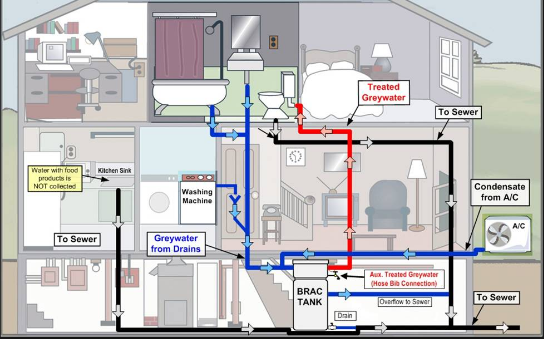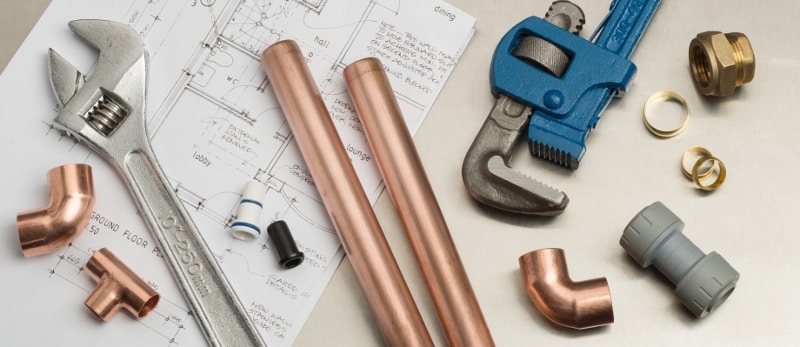Exploring The Structure of Your House's Plumbing System
Exploring The Structure of Your House's Plumbing System
Blog Article
Have you been interested in facts concerning Anatomy of a House: Understanding the Components?

Recognizing how your home's pipes system functions is important for every single homeowner. From providing tidy water for drinking, cooking, and bathing to securely getting rid of wastewater, a well-kept plumbing system is critical for your household's health and wellness and convenience. In this thorough guide, we'll check out the detailed network that makes up your home's pipes and offer suggestions on upkeep, upgrades, and taking care of usual issues.
Intro
Your home's pipes system is more than simply a network of pipes; it's a complex system that ensures you have accessibility to tidy water and effective wastewater elimination. Recognizing its components and how they work together can aid you prevent pricey repairs and guarantee everything runs smoothly.
Basic Components of a Plumbing System
Pipes and Tubing
At the heart of your plumbing system are the pipelines and tubes that bring water throughout your home. These can be constructed from various materials such as copper, PVC, or PEX, each with its advantages in terms of sturdiness and cost-effectiveness.
Fixtures: Sinks, Toilets, Showers, etc.
Components like sinks, toilets, showers, and bathtubs are where water is utilized in your home. Comprehending exactly how these fixtures connect to the plumbing system assists in detecting troubles and intending upgrades.
Valves and Shut-off Points
Shutoffs control the circulation of water in your plumbing system. Shut-off valves are important throughout emergency situations or when you require to make repairs, allowing you to isolate parts of the system without interrupting water circulation to the whole residence.
Water Supply System
Key Water Line
The main water line attaches your home to the municipal water or a personal well. It's where water enters your home and is distributed to various fixtures.
Water Meter and Pressure Regulator
The water meter steps your water usage, while a pressure regulator makes sure that water streams at a secure stress throughout your home's pipes system, protecting against damages to pipes and fixtures.
Cold Water vs. Warm water Lines
Comprehending the difference in between cold water lines, which supply water directly from the major, and hot water lines, which carry warmed water from the hot water heater, assists in troubleshooting and preparing for upgrades.
Drain System
Drain Pipes and Traps
Drain pipes carry wastewater far from sinks, showers, and bathrooms to the drain or septic tank. Catches prevent drain gases from entering your home and additionally catch debris that can trigger clogs.
Air flow Pipelines
Ventilation pipelines enable air into the water drainage system, protecting against suction that might slow water drainage and trigger traps to empty. Correct air flow is important for keeping the integrity of your pipes system.
Importance of Appropriate Water Drainage
Guaranteeing proper drain prevents backups and water damages. On a regular basis cleaning drains pipes and maintaining catches can prevent pricey repair work and expand the life of your plumbing system.
Water Heating Unit
Sorts Of Hot Water Heater
Hot water heater can be tankless or traditional tank-style. Tankless heaters warmth water on demand, while storage tanks keep heated water for immediate usage.
How Water Heaters Link to the Pipes System
Recognizing how hot water heater connect to both the cold water supply and hot water distribution lines aids in diagnosing concerns like insufficient hot water or leakages.
Maintenance Tips for Water Heaters
On a regular basis flushing your water heater to get rid of sediment, inspecting the temperature level settings, and checking for leakages can prolong its life expectancy and improve energy effectiveness.
Usual Plumbing Problems
Leakages and Their Causes
Leaks can take place as a result of maturing pipelines, loose fittings, or high water stress. Addressing leaks quickly protects against water damages and mold and mildew growth.
Clogs and Clogs
Clogs in drains pipes and toilets are typically triggered by flushing non-flushable products or a build-up of grease and hair. Using drainpipe screens and bearing in mind what drops your drains can stop clogs.
Indications of Pipes Problems to Look For
Low tide stress, slow drains pipes, foul odors, or abnormally high water costs are indicators of potential plumbing troubles that ought to be attended to promptly.
Plumbing Maintenance Tips
Regular Evaluations and Checks
Arrange annual plumbing assessments to catch issues early. Search for indicators of leakages, corrosion, or mineral buildup in faucets and showerheads.
Do It Yourself Upkeep Tasks
Straightforward jobs like cleansing tap aerators, looking for commode leakages making use of color tablet computers, or protecting revealed pipelines in cold climates can stop significant pipes problems.
When to Call a Specialist Plumber
Know when a plumbing issue requires expert know-how. Trying intricate repairs without proper expertise can bring about more damages and greater fixing prices.
Upgrading Your Plumbing System
Reasons for Upgrading
Upgrading to water-efficient fixtures or replacing old pipes can improve water quality, decrease water expenses, and raise the worth of your home.
Modern Pipes Technologies and Their Advantages
Discover technologies like smart leak detectors, water-saving toilets, and energy-efficient water heaters that can save cash and lower ecological effect.
Cost Considerations and ROI
Calculate the ahead of time prices versus long-term savings when taking into consideration pipes upgrades. Several upgrades spend for themselves through reduced energy expenses and fewer fixings.
Environmental Impact and Preservation
Water-Saving Fixtures and Devices
Setting up low-flow faucets, showerheads, and toilets can significantly decrease water use without compromising efficiency.
Tips for Decreasing Water Use
Easy behaviors like taking care of leaks promptly, taking much shorter showers, and running complete tons of laundry and recipes can preserve water and lower your energy costs.
Eco-Friendly Plumbing Options
Take into consideration lasting pipes materials like bamboo for flooring, which is durable and eco-friendly, or recycled glass for kitchen counters.
Emergency situation Readiness
Actions to Take During a Plumbing Emergency situation
Know where your shut-off valves are located and just how to shut off the water in case of a burst pipe or major leakage.
Relevance of Having Emergency Situation Contacts Handy
Keep call info for local plumbing professionals or emergency situation services readily offered for quick feedback during a pipes crisis.
Do It Yourself Emergency Situation Fixes (When Suitable).
Temporary solutions like using air duct tape to spot a leaking pipe or placing a container under a trickling faucet can lessen damages until a specialist plumber shows up.
Verdict.
Comprehending the makeup of your home's plumbing system equips you to keep it effectively, saving money and time on fixings. By following routine upkeep routines and remaining educated about contemporary pipes modern technologies, you can guarantee your plumbing system runs successfully for years to come.
HOW YOUR PLUMBING SYSTEM WORKS
Which Pipes Do What?
Blue lines = fresh water supply entering the building
Red lines = hot water supply entering the building
Grey lines = pipes carrying waste away from the building and venting pipes carrying gases away from the building (through the roof)
YOUR MAIN PLUMBING SYSTEMS
There are two main plumbing systems that support your home s basic plumbing needs one that brings clean water into your home, and one that sends dirty water away from your home. Connected to the toilet, bath, shower, and other faucets in your home, these two systems keep your water flowing in the right directions.
ACCESSING FRESH WATER
Fresh and clean water is brought into your home through the main water supply line . Filtered through one pipe, this water is pressured to flow into the various fixtures in your home at any given time.
This water can be sourced from a well located on your property, a pond or river (mostly cottages), or, as in most cases, from the city s municipal water treatment centre. However, it is important to note that water that is untreated, such as the water siphoned from ponds or rivers, may not be safe to drink. Personal water supplies always need to be treated for hardness and contaminants before consumed.
MUNICIPAL WATER SUPPLIES
Improve taste and odour
Remove sediment
Eliminate hardness
Reduce chlorine
COLD WATER SUPPLY VS. HOT WATER SUPPLY
Cold water flows into your home or building through the service line, which then distributes hot or cold water to your fixtures. This line is most commonly run through a central column that runs floor to floor. Hot water runs in short and straight pipes as the longer the pipeline, the more heat that will be lost in the transfer. Having shorter pipes also allows residents to access hot water more quickly.
WASTE WATER SYSTEM
Your wastewater system is divided into two parts pipes that send wastewater away from your home and venting pipes that send sewer gas away from your home. Sewage water travels through pipes that flush the water and waste towards local sewers that are operated and managed by your city or town. Most sewer systems rely on gravity to move the wastewater to where it needs to go.
The further away from your toilet or sink, the larger wastewater pipes become. This allows for waste to be disposed of from various parts of your home or business at once without pipe blockages. The angle and flow of these pipes are also essential for keeping your waste pipes clear of build up.
https://harrisplumbing.ca/how-your-home-plumbing-system-works/

HOW YOUR PLUMBING SYSTEM WORKS
Which Pipes Do What?
YOUR MAIN PLUMBING SYSTEMS
There are two main plumbing systems that support your home s basic plumbing needs one that brings clean water into your home, and one that sends dirty water away from your home. Connected to the toilet, bath, shower, and other faucets in your home, these two systems keep your water flowing in the right directions.
ACCESSING FRESH WATER
Fresh and clean water is brought into your home through the main water supply line . Filtered through one pipe, this water is pressured to flow into the various fixtures in your home at any given time.
This water can be sourced from a well located on your property, a pond or river (mostly cottages), or, as in most cases, from the city s municipal water treatment centre. However, it is important to note that water that is untreated, such as the water siphoned from ponds or rivers, may not be safe to drink. Personal water supplies always need to be treated for hardness and contaminants before consumed.
MUNICIPAL WATER SUPPLIES
COLD WATER SUPPLY VS. HOT WATER SUPPLY
Cold water flows into your home or building through the service line, which then distributes hot or cold water to your fixtures. This line is most commonly run through a central column that runs floor to floor. Hot water runs in short and straight pipes as the longer the pipeline, the more heat that will be lost in the transfer. Having shorter pipes also allows residents to access hot water more quickly.
WASTE WATER SYSTEM
Your wastewater system is divided into two parts pipes that send wastewater away from your home and venting pipes that send sewer gas away from your home. Sewage water travels through pipes that flush the water and waste towards local sewers that are operated and managed by your city or town. Most sewer systems rely on gravity to move the wastewater to where it needs to go.
The further away from your toilet or sink, the larger wastewater pipes become. This allows for waste to be disposed of from various parts of your home or business at once without pipe blockages. The angle and flow of these pipes are also essential for keeping your waste pipes clear of build up.
https://harrisplumbing.ca/how-your-home-plumbing-system-works/
I stumbled upon that review on Anatomy of a House: Understanding the Components while doing a search on the web. Do you know another individual who is in to Plumbing Installation 101: All You Need to Know? Be sure promote it. Thanks a lot for going through it.
Contact Us Now Report this page